History
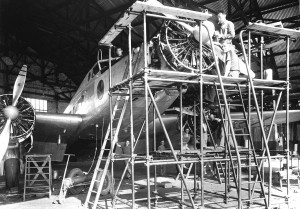
In 1935, several French engineering companies, including the major French manufacturer of steel tubes, which will later become Vallourec, come together to find markets for their products. This resulting in the creation of “Entreprise de Pose de Tous Produits Tubulaires”, soon to be renamed Entrepose. In the same year, tubular steel scaffolding makes its appearance in Europe following its invention in England. The managers at Entrepose see this development as a potential outlet for their small diameter tubes and begin the search for a connector that can be used to assemble their tubes. They find the essential component in Italy in the form of the Innocenti, a shackle named after its inventor. Thus,
Vallourec tubes coupled with Innocenti shackles give rise to the Echafaudages d’Entrepose Service. Echafaudages Service develops initially in three areas: refurbishment of façades, shuttering to support formwork and the construction of temporary structures for trade fairs and exhibitions.
War and reconstruction
Then in 1939, World War II breaks out. Later on, Entrepose will have many leading resistance figures amongst its employees, including the famous Jean Guyot, a Compagnon de la Libération, who will later become its Chief Executive. The post-war years will be busy ones for Entrepose, in particular for its Scaffolding Service. Entire cities had been flattened by shelling, whilst bridges and historic monuments had also suffered major damage. There was also the question of re-building the housing stock.
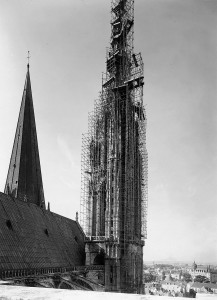 The expansion of oil industry markets and international expansion
The expansion of oil industry markets and international expansion
The 1950s marks a decisive turning point for Entrepose. Jean Guyot, leading a team of young engineers, spots the exceptional opportunities for steel tubes promised by the expansion of oil industry markets. As Managing Director in 1958, then as Chief Executive in 1962, he leads the company towards its success in international markets. All over the world, the construction of refineries is going on apace. Both in France and in Europe, Entrepose can be found on most of the sites and it confirms its position as a firmly established, international industrial undertaking. At the start of 1963, Joseph Plattier, director of the Scaffolding Service, sets about the
creation of regional branches in France. Three such branches are set up between 1962 and 1964 in Lyon, Marseille and Ile de France. At the same time, the Scaffolding Service creates
a new business, leasing tubes tubes and connectors to small building and painting companies, for fairly simple, minor structures that they can erect themselves. Boosted by this innovation, the Scaffolding Service sets out to win markets abroad and, in March 1963, the first European subsidiary sees the light of day in Spain.
The bases of an alliance
Meanwhile in 1965, Entrepose comes across GTEC, a subsidiary of Grands Travaux de Marseille. The meeting between Entrepose head Jean Guyot and Maurice Craste, GTM’s Deputy Director will see the creation of ETPM (Entreprise de Travaux Pétroliers Maritimes). This initial Entrepose/GTM collaboration is crowned with success.
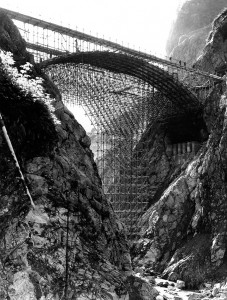 The 70s, a time of major construction work
The 70s, a time of major construction work
At the end of the 60s, France embarks on a major construction programme, with the creation of an extensive motorway network and house building. This period sees the development of shoring in major civil engineering works, such as the "périphérique", the Paris ring road.Against this background, increasing labour costs and the time-consuming nature of erecting tubes and shackles leads Scaffolding Service management to look for
a new generation of prefabricated equipment. Unlike the multipurpose nature of tubes and shackles, each family of prefabricated equipment is designed for a specific purpose. With this new generation of equipment, the rental business experiences a further upsurge in business. New branches open in Bordeaux, Rouen, Metz and Clermont-Ferrand. In 1968, Grenoble hosts the Olympic Games and the Scaffolding Service wins a huge contract for the construction of all of the fixed and temporary installations required in a 75,000-seater stadium! The size of the project is such that Mr Plattier sets up a branch in Grenoble to handle it and brings in support from Mills, France’s number 2 company. In 1969, Entrepose sets up its Entrepose TP subsidiary to deal with business in France and the Common Market. From now on, Entrepose SA concentrates all its efforts on projects in the rest of the world.
Development of the nuclear industry
From 1970, the nuclear energy industry is expanding. In France, Entrepose TP participates in the nuclear energy programme, occupying a leading position in the construction and installation of auxiliary pipework in EDF reactors and, later, in the construction of the reprocessing plant in The Hague.
Major marine developments
The know-how of Entrepose’s scaffolders opens the door to four of the largest marine projects in France: Dunkirk, St-Nazaire, le Ciotat and La Seyne sur Mer. The size of this market will give birth to a head office-based dockyards department whose turnover, after just five years in business, represents 25% of the entire business of the Scaffolding Service. In 1978, Emile Artaud becomes Director of the Scaffolding Service with the aim of exporting the new scaffolding techniques. Led by export manager Philipe Dugard, the Estub (Brazil), Enthana (Thailand) and Fassan (Iran) subsidiaries are set up. Others will follow in France’s overseas departments, Africa, Lebanon etc. The start of the 80s is a decisive moment Entrepose’s Scaffolding Service. The methane tankers for which Entrepose provided the scaffolding during their construction are returning to the dockyards for repairs. This tricky work acts as an inspiration to naval engineer Cyril Grandpierre: he has the a brilliant idea of
an assembly system made of clamps and self-locking wedge keys. It is at this moment then that Entrepose begins to manufacture
Crab, its new range of scaffolding equipment. It is a highly user-friendly, innovative technology providing semi-pre-fabricated, multidirectional equipment. Its lightness is due to the use of high-performance steel with a high yield strength and its smart self-pivoting wedge locking system makes it stand out from other systems that are appearing on the market. Entrepose’s new Chief Executive, Gérard Bontron, is quick to grasp the value of this major advance in the technology and the company invests massively in this new tool.
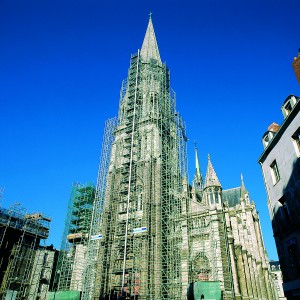 The creation of GTM-Entrepose
The creation of GTM-Entrepose
On 1 January 1982, the GTM and Entrepose groups, who are already linked via joint subsidiaries ETPM and GTME, decide to merge to form the GTM-Entrepose group, with Entrepose TP becoming a subsidiary. Entrepose brings complementary skills and markets to GTM, an established major player in construction and public works: underground pipework, scaffolding and industrial pipework (Entrepose TP) and the erection of industrial installations with Montalev. In 1987, Entrepose TP and Montalev merge to create Entrepose-Montalev, which becomes the focus for GTM-Entrepose group industrial activities. Its know-how is unequalled and its national branch network provides local service to every customer.
The expansion of the Scaffolding Service results in it being spun off as a subsidiary in December 1995, under the name Entrepose Échafaudages S.A.S. As for Entrepose-Montalev, in January 1997, for simplicity’s sake, it is renamed Entrepose S.A.
Life in the major groups
At the end of the 80s, Vallourec gradually sells its holdings in GTM-Entrepose to Dumez. Then Dumez mergers with Lyonnaise des Eaux which, in turn, soon merges with Suez.
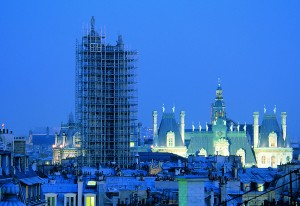 Independence
Independence
In 2000, the Suez Group sells its construction business to the Vinci Group. Only the industrial activities, in which Entrepose participates, are retained within the Suez Group, and very soon the scaffolding division is sold off too in an LBO (leveraged buyout), giving birth, on 1 February 2002, to the Scaff’Holding Group. This latest phase in our history has created an autonomy that we feel will benefit our commercial development.
 In 1935, several French engineering companies, including the major French manufacturer of steel tubes, which will later become Vallourec, come together to find markets for their products. This resulting in the creation of “Entreprise de Pose de Tous Produits Tubulaires”, soon to be renamed Entrepose. In the same year, tubular steel scaffolding makes its appearance in Europe following its invention in England. The managers at Entrepose see this development as a potential outlet for their small diameter tubes and begin the search for a connector that can be used to assemble their tubes. They find the essential component in Italy in the form of the Innocenti, a shackle named after its inventor. Thus, Vallourec tubes coupled with Innocenti shackles give rise to the Echafaudages d’Entrepose Service. Echafaudages Service develops initially in three areas: refurbishment of façades, shuttering to support formwork and the construction of temporary structures for trade fairs and exhibitions.
In 1935, several French engineering companies, including the major French manufacturer of steel tubes, which will later become Vallourec, come together to find markets for their products. This resulting in the creation of “Entreprise de Pose de Tous Produits Tubulaires”, soon to be renamed Entrepose. In the same year, tubular steel scaffolding makes its appearance in Europe following its invention in England. The managers at Entrepose see this development as a potential outlet for their small diameter tubes and begin the search for a connector that can be used to assemble their tubes. They find the essential component in Italy in the form of the Innocenti, a shackle named after its inventor. Thus, Vallourec tubes coupled with Innocenti shackles give rise to the Echafaudages d’Entrepose Service. Echafaudages Service develops initially in three areas: refurbishment of façades, shuttering to support formwork and the construction of temporary structures for trade fairs and exhibitions. The expansion of oil industry markets and international expansion
The expansion of oil industry markets and international expansion
 The 70s, a time of major construction work
The 70s, a time of major construction work
 The creation of GTM-Entrepose
The creation of GTM-Entrepose
 Independence
Independence